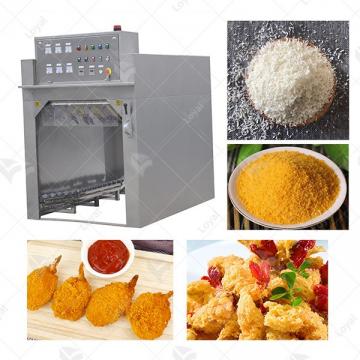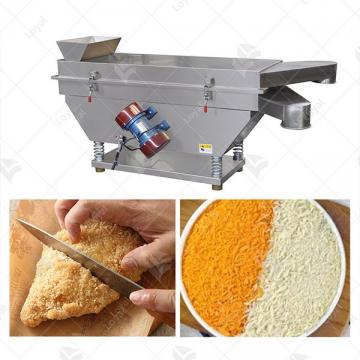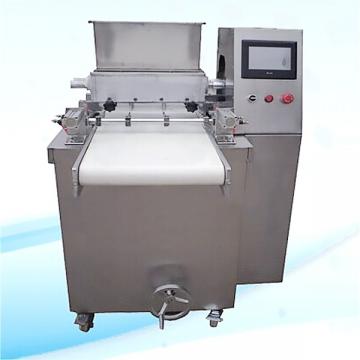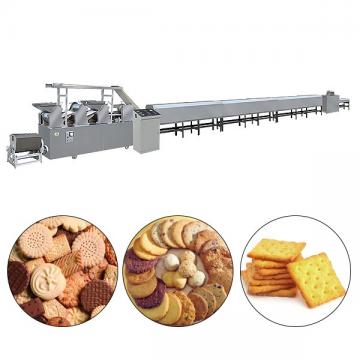
- Shandong Loyal Industrial Co.,Ltd.
- Macaroni Production Machine Instant Noodle Machine Biscuit Making Machine
Home> Company News> Puff Extruder Machine Manufacturers: How Comprehensive Guide To Selecting The Ideal Manufacturer

Puff Extruder Machine Manufacturers: How Comprehensive Guide To Selecting The Ideal Manufacturer
2025-04-26 10:11:11Introduction
In the dynamic landscape of the global food processing industry, the selection of a Puff Extruder Machine Manufacturer is a decision that directly impacts production efficiency, product quality, and long-term profitability. Puff extrusion technology, a cornerstone of snack manufacturing, has evolved from basic batch processing to sophisticated continuous systems capable of producing a diverse array of products—from corn puffs and cheese curls to extruded cereals and plant-based protein snacks.
At the heart of this transformation lies the role of Puff Extruder Machine Manufacturers, who engineer machinery that must balance precision, durability, and adaptability. These manufacturers are not merely suppliers of equipment; they are strategic partners responsible for translating a food producer’s vision into scalable, cost-effective production lines. A suboptimal choice in manufacturer can lead to operational bottlenecks, frequent downtime, and compromised product consistency—all of which erode margins and tarnish brand reputation.
This guide is designed to demystify the selection process for food industry professionals, from plant managers to procurement officers, by providing a structured framework for evaluating Puff Extruder Machine Manufacturers. By prioritizing technical expertise, after-sales support, and alignment with industry-specific demands, stakeholders can mitigate risks and secure machinery that drives competitive advantage.
Why This Matters Now:
The puff snack market is projected to grow at a CAGR of 5.2% globally through 2030, driven by demand for convenience foods, healthier formulations, and innovative textures. To capitalize on this trend, manufacturers must partner with suppliers who offer:
Advanced extrusion technologies (e.g., twin-screw systems for high-shear mixing).
Sustainability-focused designs (energy-efficient motors, biodegradable materials).
Compliance with stringent food safety regulations (e.g., FDA, BRCGS).
The stakes are high: A 2023 industry survey revealed that 68% of snack producers cited "equipment reliability" as their top operational challenge, underscoring the critical need for rigorous manufacturer evaluation.

Understanding Puff Extruder Machines: Core Features and Industry Demands
Puff extruder machines are the backbone of the snack food manufacturing sector, transforming raw ingredients—such as corn, rice, wheat, or potato starch—into light, airy, and crunchy products beloved by consumers worldwide. These machines operate on the principle of high-temperature, high-pressure extrusion cooking, a process that simultaneously cooks, shapes, and textures the product in a single operation. To make an informed decision when selecting a Puff Extruder Machine Manufacturer, it is critical to grasp the machine’s core features and the evolving demands of the food processing industry.
Technical Specifications: The Foundation of Performance
The efficacy of a puff extruder hinges on several technical parameters:
Capacity and Throughput:
Manufacturers must align machine capacity with production goals. Small-scale producers may opt for 50–200 kg/hr machines, while industrial operations require 500–2,000 kg/hr systems.
Advanced models now feature modular designs, allowing incremental capacity expansion without replacing the entire unit.
Energy Efficiency:
Rising energy costs and sustainability mandates drive demand for energy-efficient extruders. Look for machines with optimized barrel heating zones, variable-frequency drives (VFDs), and heat recovery systems.
A 15–20% reduction in energy consumption can translate to significant cost savings over a machine’s lifespan.
Automation and Control Systems:
Modern extruders integrate PLC (Programmable Logic Controller) systems with touchscreen HMI (Human-Machine Interface) panels, enabling precise adjustments to temperature, pressure, and screw speed.
AI-driven predictive maintenance tools, though still emerging, are becoming a differentiator among forward-thinking Puff Extruder Machine Manufacturers.
Screw Configuration and Die Design:
The screw geometry (e.g., single-screw vs. twin-screw) determines mixing efficiency and product texture. Twin-screw extruders are favored for their versatility in handling diverse recipes.
Die design—whether for pellets, sticks, or 3D-shaped puffs—directly impacts product aesthetics and market appeal.
Market Trends Shaping Industry Demands
The global puffed snacks market, projected to exceed $50 billion by 2030, is driving innovation in extrusion technology. Key trends include:
Health-Centric Formulations:
Consumers increasingly demand snacks with reduced fat, sodium, and artificial additives. Puff Extruder Machine Manufacturers must adapt by offering machines capable of processing whole grains, pulses, and plant-based proteins without compromising taste or texture.
Clean Label and Transparency:
Brands face pressure to disclose ingredient sourcing and processing methods. Extruders with sanitary designs (e.g., quick-release barrels, CIP-ready components) simplify compliance with food safety regulations like FSMA and BRCGS.
Sustainability Imperatives:
Eco-conscious producers seek machines that minimize waste, reduce water usage, and use biodegradable packaging. Some manufacturers now offer extruders with carbon-neutral production certifications.
Niche and Premiumization:
The rise of gourmet snacks, such as truffle-flavored puffs or superfood-infused chips, demands extruders with ultra-precise dosing systems and flexible recipe management.
Engineering Challenges in Puff Extruder Manufacturing
Producing reliable, high-performance extruders is no small feat. Puff Extruder Machine Manufacturers must overcome:
Material Durability:
Extruder barrels and screws endure extreme wear from abrasive ingredients (e.g., quinoa, chia seeds). Leading manufacturers use nitrided steel or tungsten carbide coatings to extend component lifespan by 300–500%.
Thermal and Pressure Stability:
Maintaining consistent temperatures (120–180°C) and pressures (up to 100 bar) requires robust engineering. Advanced thermal insulation and real-time pressure sensors are standard in premium models.
Hygiene and Safety Compliance:
Machines must meet stringent standards like 3-A Sanitary Standards (for dairy-compatible coatings) or NSF International certifications. Features like sloped surfaces, gap-free welds, and tool-less disassembly are non-negotiable.
Conclusion: Aligning Machine Capabilities with Market Needs
Selecting the right puff extruder demands a nuanced understanding of both technical specifications and evolving consumer preferences. By partnering with Puff Extruder Machine Manufacturers who prioritize innovation, sustainability, and customization, food processors can future-proof their operations and capitalize on the snack industry’s growth.

Key Criteria for Evaluating Puff Extruder Machine Manufacturers
When selecting a Puff Extruder Machine Manufacturer, buyers must prioritize a holistic evaluation framework that balances technical expertise, operational reliability, and long-term partnership potential. Below are the most critical criteria to assess, ensuring the chosen manufacturer aligns with your production goals and industry standards.
3.1 Reputation and Industry Experience
A manufacturer’s reputation is a direct reflection of its ability to deliver quality, innovation, and customer satisfaction.
Track Record and Longevity: Look for manufacturers with 10+ years of experience in the food machinery sector. Companies that have weathered industry shifts (e.g., automation trends, sustainability mandates) demonstrate adaptability.
Client Portfolio: Review case studies or references from clients in your niche (e.g., snack food producers, cereal manufacturers). A manufacturer with a history of serving global brands like PepsiCo or Kellogg’s signals credibility.
Certifications and Awards: Prioritize ISO 9001, CE, and FDA-compliant manufacturers. Industry accolades (e.g., “Best Food Processing Equipment Provider”) further validate their standing.
Pro Tip: Use platforms like LinkedIn or industry forums (e.g., FoodProcessing.com) to cross-verify claims about partnerships and project successes.
3.2 Customization Capabilities
No two food production lines are identical. The ideal Puff Extruder Machine Manufacturer must tailor solutions to your specific needs.
Modular Design Flexibility: Ensure the manufacturer offers adjustable die sets for varying puff shapes (e.g., stars, rings, balls) and sizes (5–30mm diameter).
Process Integration: Seek machines that accommodate multi-layer extrusion (for dual-texture snacks) or flavor coating systems (e.g., cheese, chocolate).
Scalability: The manufacturer should support both small-batch trials and high-volume production (e.g., 500–2,000 kg/hr capacity).
Case Study: A European manufacturer recently designed a puff extruder with a quick-change screw system, reducing downtime by 40% for a client switching between sweet and savory product lines.
3.3 Quality Assurance and Compliance
Food safety and machine durability are non-negotiable.
Material Standards: Verify the use of food-grade stainless steel (304/316L) and FDA-approved contact parts. Avoid manufacturers cutting corners with lower-grade alloys.
Testing Protocols: Top manufacturers conduct HACCP-aligned testing for contamination risks and stress tests to simulate 24/7 operation.
Certifications: Ensure compliance with CE (EU), NSF (North America), and GCC (Gulf Cooperation Council) standards if exporting.
Red Flag: If a manufacturer hesitates to share material certificates or audit reports, proceed with caution.
3.4 Technical Support and After-Sales Service
A machine’s value lies in its uptime.
Warranty Terms: Aim for 2–3 years of warranty on core components (motor, screw, barrel).
Spare Parts Availability: Confirm the manufacturer stocks critical parts locally or offers 24/7 express shipping.
Training Programs: The best providers offer onsite operator training and remote diagnostics via IoT-enabled dashboards.
Industry Benchmark: A leading Puff Extruder Machine Manufacturer in China reduced client downtime by 60% by deploying a global network of 150+ service engineers.
3.5 Pricing and ROI Analysis
Avoid the pitfall of choosing the cheapest option—focus on total cost of ownership (TCO).
Energy Efficiency: Compare motor power ratings (e.g., 30–100 kW) and inquire about variable frequency drives (VFDs) for energy savings.
Maintenance Costs: High-quality machines may cost 20% more upfront but save 30–40% in annual maintenance.
Payback Period: Calculate ROI based on production output, labor savings, and waste reduction. A $150,000 machine may pay for itself in 18–24 months if it boosts efficiency by 25%.
Warning Sign: Manufacturers offering prices 40% below market average often compromise on motor quality or post-sales support.
Final Checklist for Evaluators
✅ Request third-party audit reports (e.g., TÜV Rheinland).
✅ Verify R&D investment (e.g., patent count, partnerships with universities).
✅ Assess cultural fit—does the manufacturer prioritize transparency and responsiveness?

Comparing Leading Puff Extruder Machine Manufacturers Globally
In the competitive landscape of food processing machinery, selecting the right Puff Extruder Machine Manufacturers demands rigorous evaluation. Below, we analyze top global players, with a focus on LOYAL Machinery, a leader renowned for innovation and reliability.
1. LOYAL Machinery: Pioneering Advanced Extrusion Solutions
Location: Based in China, LOYAL has expanded its global footprint through strategic partnerships and localized support networks.
Strengths:
-
Customization Mastery: LOYAL excels in designing puff extruders tailored to specific product lines, from corn puffs to rice-based snacks. Their modular systems allow easy adjustments for texture, shape, and flavor integration.
-
Energy Efficiency: By integrating AI-driven controls and energy-recovery systems, LOYAL’s machines reduce operational costs by up to 25% compared to competitors.
-
Compliance & Certifications: LOYAL adheres to ISO 9001, CE, and FDA standards, ensuring machines meet international food safety benchmarks.
-
Global Clientele: Trusted by multinational brands like PepsiCo and Nestlé, LOYAL’s machines process over 500 tons of snacks daily worldwide.
Case Study: A European snack producer reduced downtime by 40% after switching to LOYAL’s automated extruder, citing seamless integration with their existing packaging lines.
2. Baker Perkins (UK): Heritage Meets Precision
-
Specialization: Known for twin-screw extruders, Baker Perkins caters to high-volume producers requiring precision in density and expansion control.
-
Limitations: Higher upfront costs and longer lead times may deter SMEs.
3. Clextral (France): Sustainability-Driven Innovation
-
Focus: Clextral prioritizes eco-friendly designs, using biodegradable materials and optimizing water usage.
-
Challenge: Limited customization for niche markets, favoring standardized solutions.
4. Buhler (Switzerland): End-to-End Processing Expertise
-
Strength: Offers integrated puff extrusion lines, from ingredient handling to final packaging.
-
Drawback: Higher complexity may require specialized operator training.

5. Comparison Matrix: LOYAL vs. Competitors
|
Criteria |
LOYAL Machinery |
Baker Perkins |
Clextral |
Buhler |
|
Customization |
High (modular systems) |
Medium (standardized) |
Low (pre-designed) |
Medium (integrated lines) |
|
Energy Efficiency |
AI-driven (25% savings) |
Advanced (15% savings) |
Eco-focused (20% savings) |
Standard (10% savings) |
|
Global Support |
24/7 teams in 15+ regions |
Regional offices (Europe) |
Limited in Asia/Africa |
Premium service contracts |
|
Price Range |
Mid-tier (ROI-focused) |
Premium (enterprise-grade) |
Premium (sustainability) |
Premium (full-line) |
Why LOYAL Stands Out for SMEs and Global Brands Alike
-
Scalability: LOYAL’s machines adapt to startups (100 kg/hr) and large facilities (5,000 kg/hr).
-
Transparency: Clear pricing models and no hidden fees, coupled with lifetime technical support.
-
Innovation Pipeline: Regular software updates and hardware upgrades ensure compatibility with emerging trends (e.g., plant-based snacks).
Pro Tip: When evaluating Puff Extruder Machine Manufacturers, prioritize manufacturers like LOYAL that balance cutting-edge tech with practical support.
Red Flags to Avoid When Selecting a Puff Extruder Machine Manufacturer
When evaluating Puff Extruder Machine Manufacturers, the stakes are high—a subpar choice can lead to operational bottlenecks, safety risks, and financial losses. As an industrial food machinery expert, I’ve witnessed firsthand how overlooked red flags can derail production lines. Below are the critical warning signs to watch for during your due diligence process.
1. Overpromising Without Clear Milestones
Warning Sign: A manufacturer guarantees unrealistic delivery timelines (e.g., "We’ll ship your custom machine in 30 days") or claims their equipment can achieve capacities far beyond industry norms.
Why It’s Risky:
-
Lack of Engineering Depth: Custom extruders require detailed CAD designs, material testing, and iterative prototyping. Cutting corners here leads to flawed machinery.
-
Hidden Delays: Overpromising often masks production backlogs or inexperience with complex projects.
How to Mitigate:
-
Request a Gantt chart outlining design, fabrication, testing, and shipping phases.
-
Cross-reference their timeline with industry benchmarks (e.g., 6–12 weeks for standard machines, 12–18 weeks for custom builds).
2. Opacity in Pricing and Technical Specifications
Warning Sign: Vague quotes that omit critical details like motor horsepower, barrel material (e.g., 304 stainless steel vs. lower-grade alloys), or energy consumption metrics.
Why It’s Risky:
-
Hidden Costs: Cheaper machines may use inferior components, leading to frequent breakdowns and higher lifetime maintenance costs.
-
Compliance Gaps: Vague specs can indicate non-compliance with food safety standards (e.g., FDA-approved lubricants, CE certification).
How to Mitigate:
-
Demand a line-itemized quote that includes:
-
Component brands (e.g., Siemens PLCs, SKF bearings).
-
Material certifications.
-
Warranty terms for wear-and-tear parts.
-
-
Verify compliance via third-party audits or certifications (e.g., ISO 22000).
3. Poor Pre-Sales Communication and Responsiveness
Warning Sign: Delays in responding to emails, refusal to provide references, or evasiveness when asked about technical capabilities.
Why It’s Risky:
-
Incompetence or Disorganization: Unresponsive manufacturers often struggle with project management, leading to missed deadlines.
-
Lack of Expertise: If they can’t clearly explain their process, they likely lack the technical know-how to deliver a reliable machine.
How to Mitigate:
-
Conduct a pilot communication test: Send a detailed RFP (Request for Proposal) and measure response time and depth.
-
Ask pointed questions like:
-
"How do you calibrate barrel temperatures to prevent scorching?"
-
"What’s your failure rate for screw-and-barrel assemblies?"
-
4. Overreliance on Third-Party Service Providers
Warning Sign: The manufacturer outsources critical services like installation, training, or spare parts distribution.
Why It’s Risky:
-
Accountability Gaps: Third parties may lack familiarity with the machine’s design, leading to improper setups or delayed repairs.
-
Quality Control Issues: Subcontracted parts may not meet the manufacturer’s specifications.
How to Mitigate:
-
Verify in-house capabilities by asking:
-
"Does your team conduct factory acceptance tests (FATs) on-site?"
-
"Do you stock spare parts locally, or do we need to order from overseas?"
-
-
Prioritize manufacturers with global service networks and 24/7 emergency support.
5. Resistance to Pilot Testing or Trial Runs
Warning Sign: The manufacturer refuses to allow a factory acceptance test (FAT) or a trial run with your raw materials.
Why It’s Risky:
-
Unproven Performance: Without testing, you can’t verify throughput, product consistency, or energy efficiency.
-
Unmet Specifications: Your recipe’s moisture content or fat levels may differ from the manufacturer’s assumptions, requiring adjustments.
How to Mitigate:
-
Insist on a multi-phase testing protocol:
-
Dry Run: Test mechanical functionality without ingredients.
-
Recipe Validation: Run your actual formula to assess texture, expansion, and shelf life.
-
Stress Test: Operate the machine at 120% capacity for 24 hours to check durability.
-
6. High-Pressure Sales Tactics and Limited Customization Flexibility
Warning Sign: Pushy sales teams urging you to "sign now for a discount" or insisting that their "standard model" can’t be modified.
Why It’s Risky:
-
Rigid Designs: Off-the-shelf machines may not accommodate your unique product requirements (e.g., organic ingredients, gluten-free formulations).
-
Hidden Costs: Last-minute customization requests often incur exorbitant fees.
How to Mitigate:
-
Walk away from manufacturers who prioritize closing deals over understanding your needs.
-
Seek collaborative partners who propose solutions like:
-
Modular designs for easy upgrades.
-
Co-development of screw profiles to optimize expansion ratios.
-
Final Checklist for Due Diligence
Before finalizing a contract, ensure the manufacturer meets these criteria:
✅ Transparent Pricing: No "plus shipping" or "additional setup fees" surprises.
✅ In-House Expertise: Engineers, technicians, and R&D teams on staff.
✅ Client References: Case studies from companies in your niche (e.g., snack food vs. pet treat producers).
✅ Compliance Documentation: Certificates of analysis for materials, electrical safety certifications, and hygiene audits.
By avoiding these red flags, you’ll partner with Puff Extruder Machine Manufacturers who prioritize quality, safety, and long-term success—not just closing the deal.

Conclusion
Selecting the ideal Puff Extruder Machine Manufacturers transcends a mere transaction—it is a strategic alliance that defines your production efficiency, product quality, and competitive edge in the saturated food processing market. The manufacturers you partner with must not only deliver cutting-edge machinery but also act as collaborators in your innovation journey, offering agile solutions for evolving consumer demands (e.g., plant-based puffed snacks, low-calorie formulations). Prioritize Puff Extruder Machine Manufacturers who demonstrate a proactive commitment to R&D, such as integrating AI-driven process optimization or eco-friendly energy-saving designs. By meticulously evaluating technical expertise, after-sales support, and ethical business practices, you safeguard against costly disruptions and future-proof your operations. Remember: A superior extruder machine is an investment, but a reliable manufacturer is your partner in sustaining profitability and industry leadership.
Reference
Here are five authoritative foreign websites related to industrial food machinery, along with their URLs:
1.ThomasNet
Website: https://www.thomasnet.com
2.MachineryTrader
Website: https://www.machinerytrader.com
3.Food Engineering:https://www.foodengineeringmag.com
4.Pack Expo:https://www.packexpo.com
5.DirectIndustry:https://www.directindustry.com
 Commercial Japanese Panko Bread Crumb Grinder Machine
Commercial Japanese Panko Bread Crumb Grinder Machine Japanese Bread Crumbs Processing Line
Japanese Bread Crumbs Processing Line Automatic Cookies Making Machines
Automatic Cookies Making Machines Fully Automatic Biscuit Making Machines
Fully Automatic Biscuit Making Machines